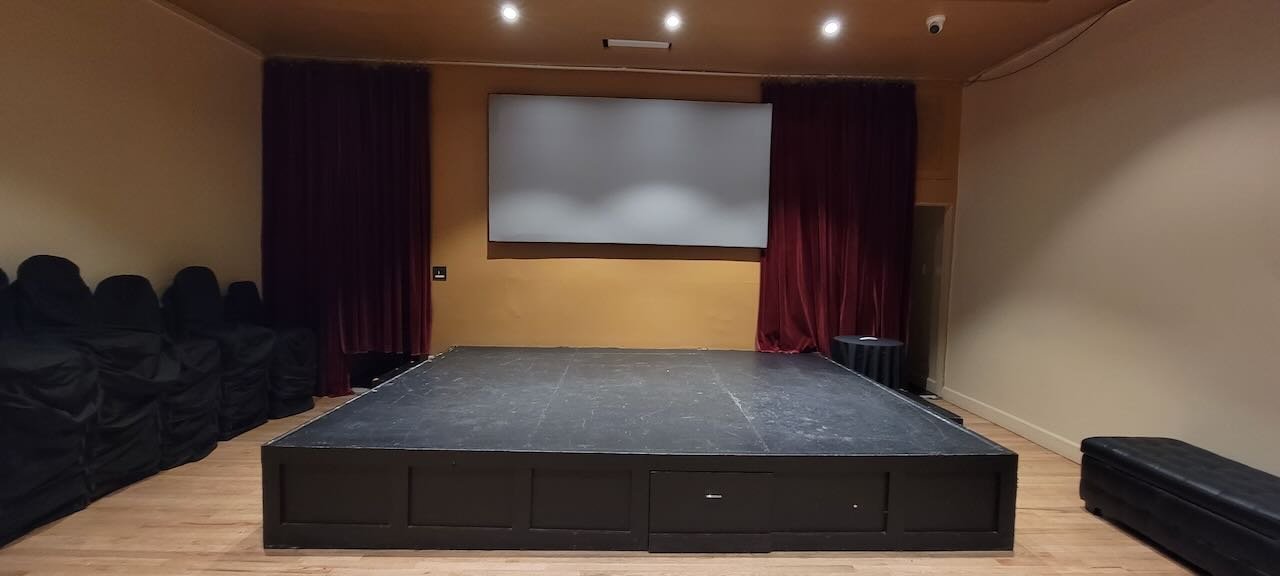For the full thirteen years of our existence, we have had the privilege of presenting our flagship Winter Cycle at La Nacional, on Manhattan’s West 14 Street. Across the spectrum of New York City’s Spanish-speaking communities, especially among performers, “La Nacional” has been a fabled place for generations. Known for flamenco and tango classes, for its restaurant, for making its space available to a wide range of events and communities whether involving Spaniards or not, it has earned respect, love and a unique profile as among the oldest, if not the oldest non-profits in New York City. It is the last vestige of the neighborhood known roughly into the 90s as “Little Spain.” This is our screening room, performance, art gallery and gathering space where we will welcome you in the great spirit of our host’s hospitality and progressive sentiment. We hope you make lifetime friends here!
THE GALLERY SPACE AT LA NACIONAL
THE RESTAURANT AT LA NACIONAL
When choosing film screenings at Bronx World Film Cycle, make a full day of it and treat your palate to the many delights of La Nacional Restaurant, directly downstairs from the gallery on the ground floor of the stately 5-floor walkup that La Nacional calls home. You’ve entered the domain of Chef-in-Residence Francisco Javier Parreño, who presides an open-format kitchen with a distinctive, cutting-edge take on Spanish classics and a carefully chosen selection of Spanish wines, beers and cocktails. We still have a date with Sopa de la Mamȧ de Paco (Paco’s Mom’s Soup), the chicken soup recipe that he inherited from his mother, and a sampling of the appetizer menu is an adventure all its own. In the summer, delight your senses with what we can only rightly describe as “molecular gazpacho,” a stunning reinvention that will defy any expectations of what gazpacho should look like and surprise even jaded diners.
The expansive, intelligently designed space encourages conversation and mobility regardless of the party size. Even the hallways to the bathroom and the bathrooms themselves welcome you, tastefully wallpapered with clippings from turn-of-the-century newspapers that tell the story of a remarkably vital, storied community. The clippings show ads for variety shows, restaurants, bullfighting, jai alai matches, country outing, shipping overseas, travel agencies, and specialized food stores (we fondly remember Casa Moneo!), among others. The restaurant is also a non-profit establishment and it supports the Society, so when you come as a patron you are supporting this most unusual and beloved New York City institution.
LA NACIONAL, REBORN
New Yorkers of a certain age and demographic who know this establishment from decades ago when the Society had come upon hard times remember it as a dark, somber, smoky old New York City-style tapas bar frequented mostly by elderly gentlemen. The first three unfortunately blurry images in the gallery below capture the end of an era in 2016 when the restaurant, doing much better at the time, closed for a top-to-bottom reconceptualization and renovation.
The rest of the series leads up to its re-opening June 15, 2018, two years later and twice as long as originally estimated. The early stages of renovation revealed that the structure needed shoring up, which literally involved “jacking” it up to apply reinforcements. For a non-profit to have its main source of revenue closed for that long represented a potentially mortal risk in a city where real estate is as valuable as it is in Manhattan. La Nacional survived and even after the ravages of COVID-19, remains standing and as vital as ever.
Credit for the jaw-dropping transformation of both restaurant and gallery space goes to Executive Director Robert Sanfiz, son of Spanish immigrants born and raised in this neighborhood, practicing lawyer and now, turnaround specialist extraordinaire who took on the position shortly before our organization found its way here in the winter of 2011. With great sacrifice and impeccable leadership, he brought the Society into a new era ensuring that it will remain a feature of the Manhattan landscape for another century and a half and beyond. We thank him and his Distinguished Board of Directors for welcoming us as one of their own from the very beginning, and proudly call ourselves a protegé institution today.

















































